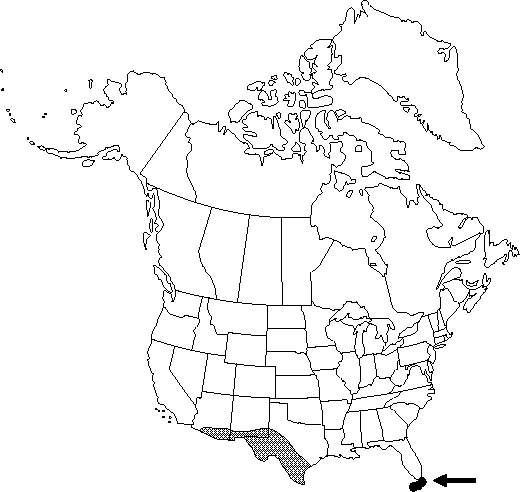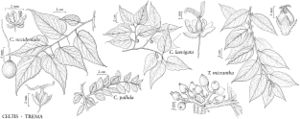Difference between revisions of "Celtis pallida"
in W. H. Emory, Rep. U.S. Mex. Bound. 2: 203. 1859.
FNA>Volume Importer |
FNA>Volume Importer |
||
| Line 16: | Line 16: | ||
|name=Celtis spinosa var. pallida | |name=Celtis spinosa var. pallida | ||
|authority=(Torrey) M. C. Johnston | |authority=(Torrey) M. C. Johnston | ||
| − | }}{{Treatment/ID/Synonym | + | }} {{Treatment/ID/Synonym |
|name=Momisia pallida | |name=Momisia pallida | ||
|authority=(Torrey) Planchon | |authority=(Torrey) Planchon | ||
| Line 34: | Line 34: | ||
|elevation=1000-1300 m | |elevation=1000-1300 m | ||
|distribution=Ariz.;Fla.;N.Mex.;Tex.;Mexico;Central America;South America (to n Argentina). | |distribution=Ariz.;Fla.;N.Mex.;Tex.;Mexico;Central America;South America (to n Argentina). | ||
| − | |discussion=<p>Celtis pallida is closely related to C. iguanaea (Jacquin) Sargent from Mexico. Reports of C. iganaea from Florida and Texas are unconfirmed. Celtis iguanaea can be identified by its longer leaves (to 4 cm wide), small fruits (4-5 mm), and single thorns. Its fruits have acid, juicy pulp.</p> | + | |discussion=<p><i>Celtis pallida</i> is closely related to C. iguanaea (Jacquin) Sargent from Mexico. Reports of C. iganaea from Florida and Texas are unconfirmed. <i>Celtis</i> iguanaea can be identified by its longer leaves (to 4 cm wide), small fruits (4-5 mm), and single thorns. Its fruits have acid, juicy pulp.</p> |
|tables= | |tables= | ||
|references= | |references= | ||
| Line 58: | Line 58: | ||
|publication year=1859 | |publication year=1859 | ||
|special status=Selected by author to be illustrated | |special status=Selected by author to be illustrated | ||
| − | |source xml=https://jpend@bitbucket.org/aafc-mbb/fna-data-curation.git/src/ | + | |source xml=https://jpend@bitbucket.org/aafc-mbb/fna-data-curation.git/src/8f726806613d60c220dc4493de13607dd3150896/coarse_grained_fna_xml/V3/V3_673.xml |
|genus=Celtis | |genus=Celtis | ||
|species=Celtis pallida | |species=Celtis pallida | ||
Revision as of 17:19, 18 September 2019
Shrubs, to 3 m; crowns rounded. Bark gray, smooth. Branches spreading, flexuous, whitish gray, with thorns, puberulent; thorns single or in pairs, 3-25 mm. Leaf blade ovate to ovate-oblong, to 2-3 × 1.5-2 cm, thickish, margins entire or crenate-dentate, apex rounded to acute; surfaces scabrous. Inflorescences cymes, 3-5-flowered, longer than petiole, flowers mostly staminate on proximal branches, terminal flower bisexual. Drupes orange, yellow, or red, ovoid, 6-7 mm; pedicel 1-2 mm.
Phenology: Flowering late winter–spring (Mar–May).
Habitat: In deserts, canyons, mesas, washes, foothills, thickets, brushland, and grassland near gravelly or well-drained sandy soil
Elevation: 1000-1300 m
Distribution

Ariz., Fla., N.Mex., Tex., Mexico, Central America, South America (to n Argentina).
Discussion
Celtis pallida is closely related to C. iguanaea (Jacquin) Sargent from Mexico. Reports of C. iganaea from Florida and Texas are unconfirmed. Celtis iguanaea can be identified by its longer leaves (to 4 cm wide), small fruits (4-5 mm), and single thorns. Its fruits have acid, juicy pulp.
Selected References
None.
